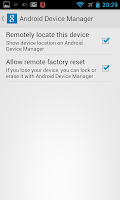To activate it on your Android device, you would click on the Google Settings Icon and then click on Android Device Manager. You must configure this on each of your Android devices since the setting is specific to the device itself. After doing this, you will then turn on the "Remotely location this device" and/or "Allow remote factory reset" depending on what you want to activate.
 In order for the location to work, the phone must have data enabled or be connected to the wireless network. After you've activated Android Device Manager on your Android device, in order to test it or use it, what you will have to do is log onto your Google account and go to the following website: https://www.google.com/android/devicemanager
In order for the location to work, the phone must have data enabled or be connected to the wireless network. After you've activated Android Device Manager on your Android device, in order to test it or use it, what you will have to do is log onto your Google account and go to the following website: https://www.google.com/android/devicemanagerFrom the website, users can get an approximate location of where their Android device is as well as cause it to ring. The ring can be deactivated on the device itself by pushing the on/off button on your Android device so this feature is used mainly to find your device if you are in close proximity to it. For example, if you've misplaced your phone at home (or at work), instead of calling your phone (where your phone might be muted), you can log onto the above website on a computer and force your phone to ring. This will automatically unmute your phone, raise the volume to the maximum, and sound an alarm/ring. From the sound, depending on your proximity to your Android device, you should be able to locate your it. Left undisturbed, your phone or Android device will ring for approximately 5 minutes. As mentioned above, anyone can turn off the alarm by pushing the on/off button on your device.
During my testing, I have found that the Android Device Manager is sometimes problematic and sometimes it will work while other times it won't work. This is for both the ringing of the device and the locating of the device feature.
I have not tried using the "Erase Device" feature mainly because I didn't want the hassle of re-installing all my applications and re-configuring the device again. You can scroll through the Android devices which have been installed using your Google account.
The Android Device Manager website also allows users to rename their device in case they want to change the name that Google automatically used to identify the device. In the above screenshot, I renamed the name that Google gave for the Android installation on my HP Touchpad to "HP Touchpad" from the default name which I believe was a shortened form of Cyanogenmod with the version number.
Android Device Manager offers basic features for locating and protecting your Android device. Hopefully, Google adds more features to this. Even though Android Device Manager currently only offers basic features, I do find that the features are very good and have no issues recommending people to activate it on their Android device(s). It probably won't stop a thief from stealing your Android device but it might help you find your device from a thief depending on how fast you act and whether the thief has had a change to circumvent the Android Device Manager features. Since the features rely on an active data connection or your device being connected to a WiFi access point, a thief could easily circumvent the features by either turning off data or putting your Android device into Airplane Mode.
If you have any comments/questions regarding this blog entry, please don't hesitate to leave a comment in the comments section below. Please note that the comments are moderated and any comment containing a URL link (whether embedded or not) will automatically be flagged as spam and will not be posted.










